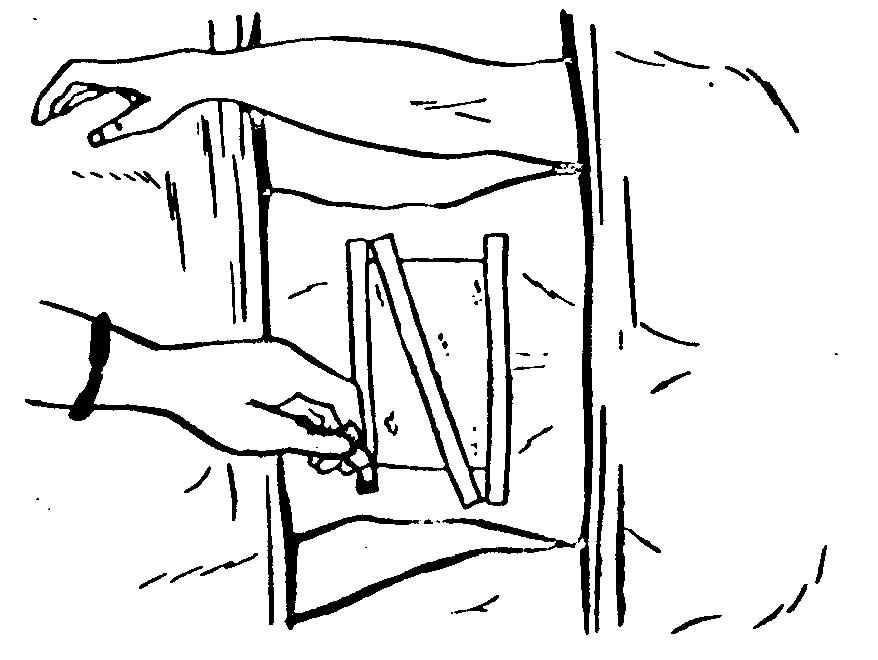Sterile Procedures
LESSON 4: Procedures Used in Wound Care
4-5
4-5. REMOVING A SOILED DRESSING
Incisions and wounds that have been sutured will normally have two layers of dressing. One layer consists of gauze pads laid directly over the closed cut. A larger dressing will then be placed over the gauze pads. This second (outer) dressing covers more area than the inner dressing (gauze pads). If the wound is on the arm or leg, the dressings are normally secured with a bandage. If the wound is on the trunk of the body, such as an abdominal wound, the outer dressing is normally secured by tape. In the following example, the sterile dressing being changed covers an abdominal wound.
a. Verify Patient's Identity. Make sure that the patient whose dressing is to be changed is the patient for whom the action was ordered. Ask the patient his name. Also compare the patient's name on the orders with the name listed on the patient's bed card and identification bracelet.
b. Reassure the Patient. Provide privacy if possible by placing a screen or curtain around the patient or by closing the door. Gain the patient's help and confidence by telling him why you are changing the dressing.
c. Wash Hands. Perform a patient care handwash. Handwashing may not always be possible in a field situation; however, every effort should be made to provide handwashing facilities.
d. Obtain Necessary Equipment and Supplies. The following items are normally used.
(1) Dressings--4-in x 4-in (10-cm x 10-cm) and 4-in x
8-in (10-cm x 20-cm) sponges.
(2) Gauze pads (sponges).
(3) Cotton-tipped applicators gauze pads may be used instead.
(4) Tape.
(5) Adhesive solvent.
(6) Basins for adhesive solvent and for normal saline.
(7) Sterile towels (for sterile field).
(8) Gloves.
(9) Scissors.
(10) Sterile forceps.
(11) Saline solution.
(12) Solution basin, if applicable.
(13) Drain, if applicable.
e. Prepare the Patient. Position the patient so that the wound site is easily accessible. Expose the wound area by removing the patient's clothing and/or by folding the bed linens, gown, or pajamas away from the wound area. Do not expose any more of the patient's body than is necessary.
f. Prepare the Work Area.
(1) Clear all items off the bedside stand or the over-the-bed table.
(2) Clean and dry area where the sterile field will be established if needed.
(3) Cut the tape strips to the size that is required to secure the dressing.
(4) Attach one end of each tape strip to an area that can be easily reached.
(5) Pour adhesive solvent into the solvent basin.
(6) Pour the disinfecting solution into a solution basin.
(7) Put on mask and sterile gloves.
g. Remove 0uter Dressing. Do not put pressure on the wound when removing the dressings. Pressure causes pain, additional injury, and interferes with the healing process.
(1) Loosen the ends of the tape attached to the patient's skin (figure 4-5).
Figure 4-5. Removing tape.
(2) Peel ends toward the wound while holding the skin with the other hand. Do not remove tape in a direction away from the wound. If you peel going away from the outer dressing, you will create tension on the wound, which may disrupt the scab or tear the skin.
(3) Once the tape has been separated from the skin, remove the dressings.
(4) Check the dressings for odor, discoloration, and drainage.
(5) Discard the outer dressing in a contaminated waste container.
h. Prepare to Remove Inner Dressings.
(1) Wash your hands.
(2) Unfold the sterile towels so as to create a sterile field.
(3) Put on sterile gloves and mask.
i. Remove Inner Dressings.
(1) Grasp the edge of the top inner dressing with the forceps and gently roll the dressing off the wound.
(a) Point the tips of the forceps downward.
(b) If the dressing sticks to the wound, moisten the dressing with sterile water to soften surface of wound. If moistening the dressing does not loosen the dressing, check with your supervisor.
(2) Check the dressings for odor, color, and drainage. Report any abnormal wound drainage to your supervisor.
(3) Discard the dressing into a contaminated waste container without touching the contaminated side of the dressing to yourself or to any surface.
(4) Continue until all of the inner dressings have been removed and discarded.
(5) Drop forceps onto the glove wrap.
j. Remove the Adhesive. Gently rub a solvent-soaked cotton-tipped applicator or gauze pad over the adhesive around the wound. Removing the adhesive that sticks to the skin reduces the chance for skin breakdown (irritation) and adds to the patient's comfort.
k. Observe Skin and Wound Site. Observe the skin for signs of irritation (redness, rash, and/or swelling). Inspect the wound for:
(1) Redness.
(2) Swelling.
(3) Pus (usually yellow fluid; may be blood-tinged, greenish, or brown).
(4) Putrid (bad) odor.
(5) Unusual color.
(6) Condition of suture (joining of edges of wound).
(7) Condition of drains.
(8) Healing.


